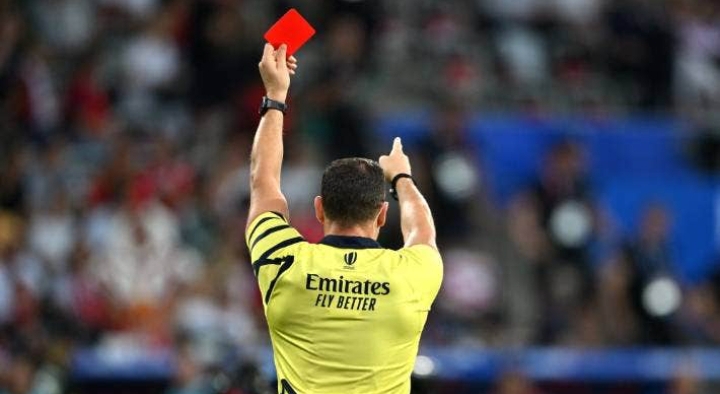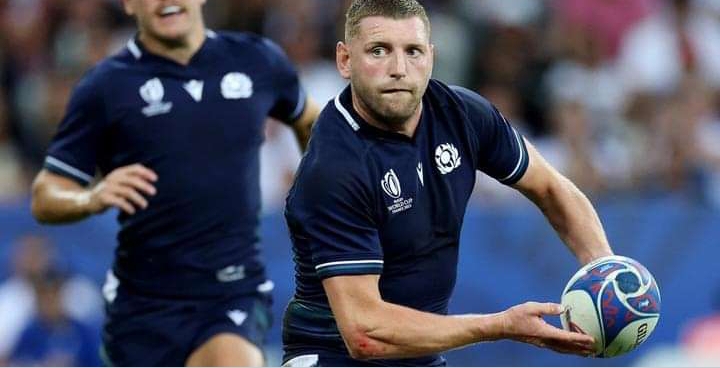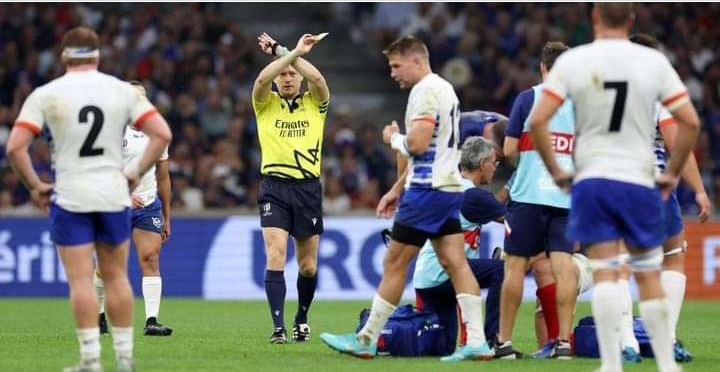Boot-to-face red card and ball-to-head try in the 2023 Rugby World Cup.

Stuff will analyze the most controversial refereeing decisions from the previous weekend’s games every Monday during the Rugby World Cup.
The Rugby World Cup has finished its second round of pool play, and the judiciary is starting to get busier.
There are currently three games scheduled for early this week (before any potential additions from Monday morning’s [NZ time] three games) after just one hearing through the first lot of eight games.
Keep in mind that any player who is shown a red card automatically receives a summons to appear before an impartial judicial committee, as do any others who are cited after the game for red-card standard offenses.
Despite the fact that the majority of these charges are usually the result of risky tackles and World Rugby’s crackdown on head contact, there was a particularly odd one last weekend.
Portugal played in their first World Cup match since their lone other appearance at the tournament in 2007, and a boot-to-face play brought back memories of a Bledisloe Cup incident from two years prior.
Portugal’s Vincent Pinto is sent off in the 77th minute of the Wales v.
Portugal match.
For kicking Josh Adams of Wales, Vincent Pinto of Portugal was given a red card.
The Portuguese gave a valiant effort in their defeat to the Welsh on Sunday (NZ time) in Nice, even though the game was all but over (21-8, finishing 28-8), and it ended on a sour note with a red card.
The ball was successfully collected by Portugal winger Vincent Pinto after he successfully leaped to take a high kick, but as he descended, Josh Adams of Wales, who was filling in for Pinto, was struck by Pinto’s extended right leg.
Fortunately for Pinto, he managed to land without incident when it appeared that he might be tipped onto his head; however, Adams was upset after suffering an eye injury.
After receiving some advice from assistant referee Andrea Piardi of Italy, referee Karl Dickson of England asked TMO Marius Jonker of South Africa to get involved.
Do we think that’s an abnormal position for the foot, Dickson questioned aloud.
Dickson decided that the act had indeed met the criteria for intentional foul play after watching the obligatory two replays on the big screen.
As play entered the 83rd minute, Dickson was given the call to wave the red, just before Wales kicked the game-winning conversion.
The bunker, another World Cup TMO based at Roland Garros, then has eight minutes to decide if the yellow should stand, or be upgraded to a red card.
But was Pinto actually at fault in this case?
He was found guilty of violating Law 9.11 (Foul Play – Dangerous Play), which states that players are not allowed to act recklessly or dangerously toward others.
Reckless is defined as “the player knew, or should have known, that there was a risk of committing an act of foul play, but carried out anyway” in a World Rugby website video explaining their disciplinary process.
There is no penalty if the criminal activity was instead classified as an accident.
If Portugal decides to contest the charge, it will be interesting to see how they fare.
Adams was at risk of being struck in the face by the jumper because of his proximity to him, but to this eye, Pinto’s actions do not appear careless because his leg was not bent and powering into a kicking motion the entire time, and it was rather straight.
For kicking Marika Koribete in the face, Jordie Barrett is dismissed from the game.
The All Blacks No. 15 initially received a red card for striking Wallabies winger Marika Koroibete in the face with his boot, but the judiciary later overturned the decision.
Barrett’s leg actually flicked out, and it did so much more violently than Pinto’s contact.
When trying to regain his balance on the downward trajectory, the opponent’s boot unintentionally made contact with the opponent’s head, the Sanzaar judicial committee chair noted in his findings for that incident.
So there is no doubt that Pinto and Portugal have a good chance of overturning the decision.
England scores a falco try against Japan in the 56th minute.
England benefits from having Joe Marler’s mind.
This one should be considered a strong contender for the tournament’s strangest try.
Midway through the second half, with the score tied at 13-12, England flanker Courtney Lawes walked over for the simplest of five-pointers as England went on to defeat Japan 34-12 in Nice on Monday (NZT).
A ball spilled forward in midfield and bounced into Lawes’ arms, which caused the Japanese defenders to halt in their tracks.
Jamie Joseph, the coach, would have been right to be incensed at his players’ inaction after the ball was discovered to not have been a knock on after all, if you recall the one that is drilled into young children: “Always play to the whistle.”
Instead, it struck England prop Joe Marler in the head, where it bounced.
According to World Rugby, a knock on occurs when a player loses control of the ball and it moves forward, when a player strikes the ball with their hand or arm and it moves forward, or when the ball strikes a player’s hand or arm and moves forward before the original player can catch it.
For what it’s worth, the arm includes the shoulder.
On Friday (NZT), during France’s victory over Uruguay, this was clearly demonstrated when the hosts had a try disallowed in the 50th minute.
Referee Nika Amashukeli of Georgia was right on the money with his on-field decision of “try” in this instance when he asked TMO Joy Neville of Ireland to confirm via large-screen replays.
But there were still a few things to double-check.
First-five George Ford passed to prop Will Stuart, who touched the ball before it reached Marler’s head.
Play continued, though, as the ball bounced off his hand and moved backward.
As Lawes approached Marler to play the ball, the referees had to watch out that he wasn’t approaching from an offside position.
It would have been Stuart’s fault if he had picked it up.
But everything was in order.
It’s unusual for props to claim try assists, much less with their melons.
Samisoni Taukei’aho’s try for New Zealand in the 16th minute against Namibia was disallowed.
Due to a glitch at lineout time, Samisoni Taukei’aho’s try was nullified.
The All Blacks scored a rolling maul try post-lineout to open Saturday’s (NZT) 71-3 rout of Namibia in Toulouse, and it appeared to be as legal as they come.
Samisoni Taukei’aho, a hooker, had his score overturned by referee Luke Pearce of England due to a technical foul committed at the lineout by the men in black, as observed by keen TMO Brian MacNeice of Ireland.
The whistler was also able to identify the obstruction when Pearce requested to display it on the big screen.
When Brodie Retallick went up to take the lineout ball, Ofa Tuungafasi and Sam Whitelock moved in front of him to form the maul.
According to World Rugby’s law 9.3 (Foul play – Obstruction), a player cannot knowingly stop an opponent from tackling or attempting to tackle the ball carrier.
A maul must form properly even though it could be viewed as a type of organized obstruction in and of itself.
Tuungafasi and Whitelock needed to bind beside or behind Retallick because there needed to be at least a chance for the opposing team to be able to initially get to the ball carrier rather than having teammates block their way.
Even though this was never going to matter in a rout, forwards coach Jason Ryan would have at least had something to hold his players accountable for had it happened in one of their future marquee contests.






